Sir Tom Blundell | |
|---|---|
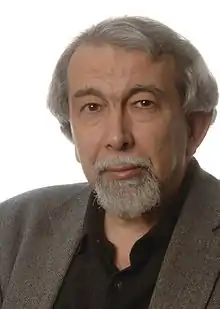 Blundell in 2006 | |
| Born | Thomas Leon Blundell 7 July 1942[1] Brighton, England, UK |
| Education | Steyning Grammar School |
| Alma mater | University of Oxford (BA, DPhil)[1] |
| Known for | |
| Spouse |
Lady Bancinyane Lynn Sibanda
(m. 1987) |
| Children | 3[3] |
| Awards |
|
| Scientific career | |
| Fields | |
| Institutions | |
| Thesis | The determination by X-ray diffraction methods of the crystal and molecular structures of some co-ordination compounds (1969) |
| Doctoral advisor | Herbert M Powell[6] |
| Doctoral students | |
| Website | www |
Sir Thomas Leon Blundell, FRS FRSC FMedSci MAE (born 7 July 1942) is a British biochemist, structural biologist, and science administrator. He was a member of the team of Dorothy Hodgkin that solved in 1969 the first structure of a protein hormone, insulin. Blundell has made contributions to the structural biology of polypeptide hormones, growth factors, receptor activation, signal transduction, and DNA double-strand break repair, subjects important in cancer, tuberculosis, and familial diseases.[11] He has developed software for protein modelling and understanding the effects of mutations on protein function, leading to new approaches to structure-guided and Fragment-based lead discovery. In 1999 he co-founded the oncology company Astex Therapeutics, which has moved ten drugs into clinical trials. Blundell has played central roles in restructuring British research councils and, as President of the UK Science Council, in developing professionalism in the practice of science.[12]
Education

Born in Brighton in 1942, Blundell was educated at Steyning Grammar School. He was the first in his family to attend university, winning an Open Scholarship to the University of Oxford. He earned a First Class degree in Natural Sciences in 1964, then moved to research in the Department of Chemical Crystallography, first with Herbert Marcus Powell FRS for his Doctor of Philosophy degree[6] and later working on insulin with Dorothy Hodgkin. He was a Junior Research Fellow at Linacre College, University of Oxford, where he is now an Honorary Fellow.
Career and research
Blundell's early posts were at the University of Oxford and the University of Sussex. In 1976, Blundell joined the Department of Crystallography at Birkbeck, University of London, becoming head of department in 1978.
In 1991, while continuing academic research, he moved further into science administration and policy, as Director General of the Agricultural and Food Research Council (1991–94) and then the founding Chief Executive of the Biotechnology and Biological Sciences Research Council (BBSRC) (1994–1996). He is a former president of the Biosciences Federation (2004–06). In June 2011 he became President of the Science Council.
In 1995 he became the fifth Sir William Dunn Professor of Biochemistry and head of the Department of Biochemistry at the University of Cambridge;[13] he currently also holds the Chair of the School of Biological Sciences at that university. He is a fellow of Sidney Sussex College. His speciality is molecular biology and his research on identifying the chemical processes of diseases has led to the development of drugs to treat Aids, cancer, cataracts and diabetes. He is the co-founder of two drug discovery companies, Astex Technology Ltd and Biofabrika.
On 15 September 2010, Blundell, along with 54 other public figures, signed an open letter published in The Guardian, stating their opposition to Pope Benedict XVI's state visit to the UK.[14]
Blundell has been active on environmental issues, first as Chair of the Planning Committee of the Oxford City Council (1970–73), during the time when it stopped the building of a motorway through the city centre, pedestrianised much of the historic centre, and made North Oxford a conservation area. From 1998 to 2005 he was Chair of the Royal Commission on Environmental Pollution,[15] when he oversaw the production of key reports such as those on Energy – the Changing Climate, Chemicals in Products – Safeguarding the Environment and Human Health, and Turning the Tide: Addressing the Impact of Fisheries on the Marine Environment.[16] He is a Distinguished Member of Humanists UK.[17]
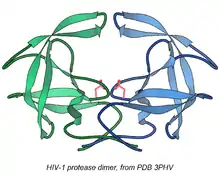
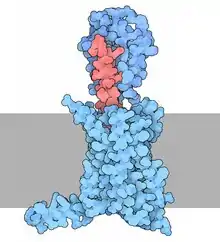
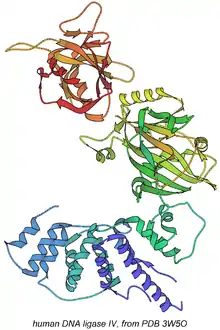
Blundell's research interests lie in elucidating the architecture and function of macromolecules and their multi-component assemblies using methods from biochemistry, protein crystallography, and bioinformatics, with the objectives of understanding biological function, of knowledge-based prediction of structure, and of discovering new therapeutics for cancer and tuberculosis.[5][11] Systems studied include DNA repair, hormones, growth factors and hormone/receptor interactions, cellular signalling, crystallins (lens proteins), renin and HIV protease. He has contributed 235 crystal structures to the worldwide Protein Data Bank (accessed 3/3/16). At least seven of the Molecule-of-the-Month features at the RCSB site of the worldwide Protein Databank have featured molecular structures solved and studied by the Blundell lab, such as the glucagon hormone shown at left in David Goodsell's drawing,[18][19] nerve growth factor,[20][21] the RAD51-BRCA2 DNA recombination complex,[22][23] and the DNA ligase shown at right.[24][25] His group has written several broadly used bioinformatics programs.[26][27][28][29][30] He co-authored a textbook on protein crystallography with Louise Johnson,[31] which was translated into French and Russian.
Doctoral students and postdocs
Blundell has supervised numerous Doctor of Philosophy students and postdoctoral researchers in his lab including Tim Hubbard,[7] Laurence Pearl,[8] Andrej Šali,[9] and Charlotte Deane.
Awards and honours
Blundell was elected a Fellow of the Royal Society (FRS) in 1984.[32] His nomination reads:
Professor of Crystallography, Birkbeck College, University of London. Distinguished for his work on crystal and molecular structures and biochemistry of protein hormones, enzymes, and proteins of the eye lens. He had an outstanding part in solution of the insulin crystal structure. He has related his structure for glucagon to receptor binding of this hormone. In chemically modified insulins he has studied structure-function relationships and he has proposed a model for the evolution of insulin. His work on avian pancreatic polypeptide, the acid proteinases from mammals and fungi and the proteins of the eye lens is characterised by similar extensive detail from which he disects [sic] important structural relationships and derives principles and guides on protein evolution and hormone (especially growth hormone) function.[32]
Blundell became one of the first fellows of the Academy of Medical Sciences in 1998.[33] He was elected a member of the European Molecular Biology Organisation (EMBO) in 1985;[4] A member of the Academia Europaea in 1993; Founding Member, Academy of Medical Sciences 1999. International recognition has come in his election as a Foreign Member of the Indian National Science Academy, the Chilean Academy and The World Academy of Sciences TWAS.
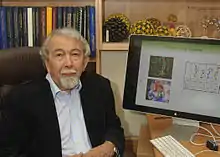
Blundell has received numerous awards and medals, including the Alcon Award for Vision Research in 1986; Gold Medal, Institute of Biotechnology in 1987; Krebs Medal FEBS 1987; Ciba Medal, Biochemical Society in 1988; Feldberg Prize in Biology and Medicine in 1988; Gold Medal, Society of Chemical Industry in 1996; First Recipient, Pfizer European Prize for Innovation in 1998 and Bernal Lecture, Royal Society 1998.[34] Most recently he received the 2013 Biochemical Society Award and Cambridge University Science Prize called the Philosophical Society Fellows Prize & Lecture 2014. He has been President, UK Biosciences Federation (2003–2009); President, Biochemical Society (2009–2011); and President, UK Science Council (since 2011).
Blundell's contributions were recognised by a knighthood in 1997. He has been awarded Honorary Doctorate degrees from 16 universities and was interviewed by Kirsty Young on the BBC Radio 4 programme Desert Island Discs in 2007.[35]
Personal life
Blundell married Lady Bancinyane Lynn Sibanda in 1987[1] and has three children.[3] His brother is the economist Richard Blundell.
Blundell was elected to the Oxford City Council in 1970 as a Labour councillor for the St. Clement’s Ward.[36]
References
- 1 2 3 4 Anon (2015). "Blundell, Sir Thomas Leon, (Sir Tom)". Who's Who (online Oxford University Press ed.). A & C Black. doi:10.1093/ww/9780199540884.013.U7914. (Subscription or UK public library membership required.)
- ↑ Blundell, T.; Cutfield, J.; Cutfield, S.; Dodson, E.; Dodson, G.; Hodgkin, D.; Mercola, D.; Vijayan, M. (1971). "Atomic positions in rhombohedral 2-zinc insulin crystals". Nature. 231 (5304): 506–511. Bibcode:1971Natur.231..506B. doi:10.1038/231506a0. PMID 4932997. S2CID 4158731.
- 1 2 Cambridge, University of (29 March 2018). "The multi-talented scientist who finds inspiration in far-flung places". Medium.com. Retrieved 3 July 2018.
- 1 2 Anon (1996). "Tom L. Blundell". people.embo.org. Heidelberg: European Molecular Biology Organization.
- 1 2 3 4 5 Tom Blundell publications indexed by Google Scholar
- 1 2 Blundell, Tom (1967). The Determination by X-Ray diffraction methods of the crystal and molecular structures of some co-ordination compounds : a study of the stereochemistry of pentaco-ordination. ora.ox.ac.uk (DPhil thesis). University of Oxford. Copac 34750152.

- 1 2 Hubbard, Timothy John Philip (1988). The design, expression and characterisation of a novel protein. london.ac.uk (PhD thesis). University of London. OCLC 940320228. Copac 29528696.
- 1 2 Pearl, Laurence (1991). Crystallographic studies of endothiapepsin. london.ac.uk (PhD thesis). London, Birkbeck College. OCLC 1000934521.
- 1 2 Sali, Andrej (1991). Modelling three-dimensional structure of a protein from its amino acid sequence. london.ac.uk (PhD thesis). London, Birkbeck College. OCLC 500526292. EThOS uk.bl.ethos.415316.
- ↑ Deane, Charlotte (2000). Protein structure prediction: amino acid propensities and comparative modelling (PhD thesis). EThOS uk.bl.ethos.598479.
- 1 2 Tom Blundell publications indexed by the Scopus bibliographic database. (subscription required)
- ↑ "Professor Sir Tom Blundell FRS FMedSci". British Humanist Association. Retrieved 22 March 2014.
- ↑ Šali, A.; Blundell, T. L. (1993). "Comparative Protein Modelling by Satisfaction of Spatial Restraints". Journal of Molecular Biology. 234 (3): 779–815. doi:10.1006/jmbi.1993.1626. PMID 8254673.
- ↑ "Letters: Harsh judgments on the pope and religion". The Guardian. London. 15 September 2010. Retrieved 16 September 2010.
- ↑ "Royal Commission on Environmental Pollution". Rcep.org.uk. Retrieved 3 July 2018.
- ↑ "Turning the Tide (RCEP report #25)" (PDF). Rcep.org.uk. Retrieved 3 July 2018.
- ↑ "British Humanist Association – Distinguished supporters:Sir Tom Blundell".
- ↑ Sasaki K, Dockerill, Adamiak DA, Tickle IJ, Blundell TL (1975). "X-ray analysis of glucagon and its relationship to receptor binding". Nature. 257 (5529): 751–757. Bibcode:1975Natur.257..751S. doi:10.1038/257751a0. PMID 171582. S2CID 4183707.
{{cite journal}}: CS1 maint: multiple names: authors list (link) - ↑ "Glucagon Molecule-of-the-Month". Pdb101.rcsb.org. Retrieved 3 July 2018.
- ↑ McDonald, Neil Q.; Lapatto, Risto; Rust, Judith Murray; Gunning, Jennifer; Wlodawer, Alexander; Blundell, Tom L. (1991). "New protein fold revealed by a 2.3-Å resolution crystal structure of nerve growth factor". Nature. 354 (6352): 411–414. Bibcode:1991Natur.354..411M. doi:10.1038/354411a0. ISSN 0028-0836. PMID 1956407. S2CID 4346788.
- ↑ "Neurotrophins Molecule-of-the-Month". Pdb101.rcsb.org. Retrieved 3 July 2018.
- ↑ Pellegrini L, Yu DS, Anand S, Lee M, Blundell TL, Venkitaraman AR (2002). "Insights into DNA recombination from the structure of a RAD51-BRCA2 complex". Nature. 420 (6913): 287–293. Bibcode:2002Natur.420..287P. doi:10.1038/nature01230. PMID 12442171. S2CID 4359383.
- ↑ "RecA and Rad51 Molecule-of-the-Month". Pdb101.rcsb.org. Retrieved 3 July 2018.
- ↑ Ochi T, Gu X, Blundell TL (2013). "Structure of the catalytic region of DNA ligase IV in complex with an artemis fragment sheds light on double-strand break repair". Structure. 21 (4): 672–679. doi:10.1016/j.str.2013.02.014. PMC 3664939. PMID 23523427.
- ↑ "DNA ligase Molecule-of-the-Month". Pdb101.rcsb.org. Retrieved 3 July 2018.
- ↑ Lewis, T. E.; Sillitoe, I; Andreeva, A; Blundell, T. L.; Buchan, D. W.; Chothia, C; Cuff, A; Dana, J. M.; Filippis, I; Gough, J; Hunter, S; Jones, D. T.; Kelley, L. A.; Kleywegt, G. J.; Minneci, F; Mitchell, A; Murzin, A. G.; Ochoa-Montaño, B; Rackham, O. J.; Smith, J; Sternberg, M. J.; Velankar, S; Yeats, C; Orengo, C (2013). "Genome3D: A UK collaborative project to annotate genomic sequences with predicted 3D structures based on SCOP and CATH domains". Nucleic Acids Research. 41 (Database issue): D499-507. doi:10.1093/nar/gks1266. PMC 3531217. PMID 23203986.
- ↑ Lewis, T. E.; Sillitoe, I; Andreeva, A; Blundell, T. L.; Buchan, D. W.; Chothia, C; Cozzetto, D; Dana, J. M.; Filippis, I; Gough, J; Jones, D. T.; Kelley, L. A.; Kleywegt, G. J.; Minneci, F; Mistry, J; Murzin, A. G.; Ochoa-Montaño, B; Oates, M. E.; Punta, M; Rackham, O. J.; Stahlhacke, J; Sternberg, M. J.; Velankar, S; Orengo, C (2015). "Genome3D: Exploiting structure to help users understand their sequences". Nucleic Acids Research. 43 (Database issue): D382-6. doi:10.1093/nar/gku973. PMC 4384030. PMID 25348407.
- ↑ Mizuguchi, K.; Deane, C. M.; Blundell, T. L.; Overington, J. P. (1998). "HOMSTRAD: A database of protein structure alignments for homologous families". Protein Science. 7 (11): 2469–2471. doi:10.1002/pro.5560071126. PMC 2143859. PMID 9828015.
- ↑ Shi, J.; Blundell, T. L.; Mizuguchi, K. (2001). "FUGUE: Sequence-structure homology recognition using environment-specific substitution tables and structure-dependent gap penalties". Journal of Molecular Biology. 310 (1): 243–257. doi:10.1006/jmbi.2001.4762. PMID 11419950.
- ↑ Pandurangan, Arun Prasad; Ochoa-Montaño, Bernardo; Ascher, David B.; Blundell, Tom L. (3 July 2017). "SDM: a server for predicting effects of mutations on protein stability". Nucleic Acids Research. 45 (W1): W229–W235. doi:10.1093/nar/gkx439. ISSN 0305-1048. PMC 5793720. PMID 28525590.
- ↑ Blundell TL, Johnson LN (1976), Protein Crystallography, Academic Press, ISBN 0121083500
- 1 2 Anon (1984). "EC/1984/03: Blundell, Sir Thomas Leon". royalsociety.org. London: Royal Society. Archived from the original on 16 January 2016. Retrieved 13 June 2014.
- ↑ "The Academy of Medical Sciences | Directory". Archived from the original on 1 October 2006. Retrieved 6 January 2009.
- ↑ "Past medals, awards and prize lectures". royalsociety.org. Retrieved 4 October 2017.
- ↑ "Kirsty Young's castaway this week is the leading scientist Professor Sir Tom Blundell". Bbc.co.uk. Retrieved 3 July 2018.
- ↑ "Prof. Tom Blundell: A Personal History of Science and Ethics".